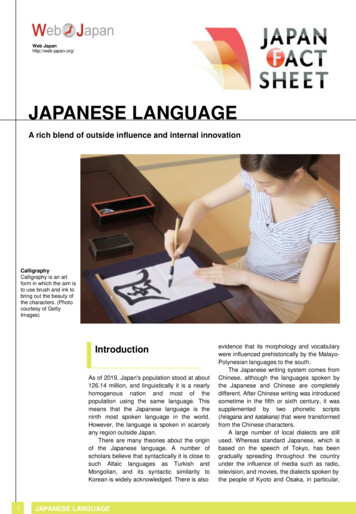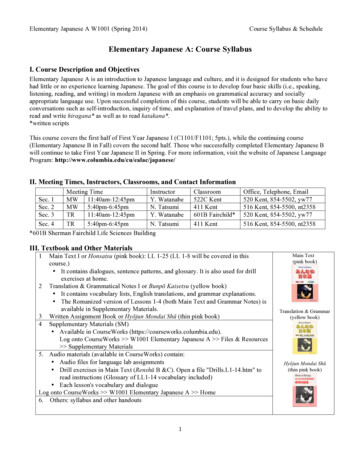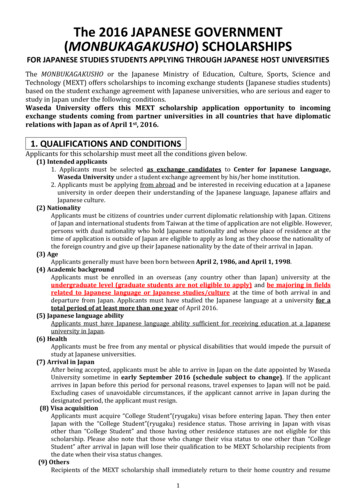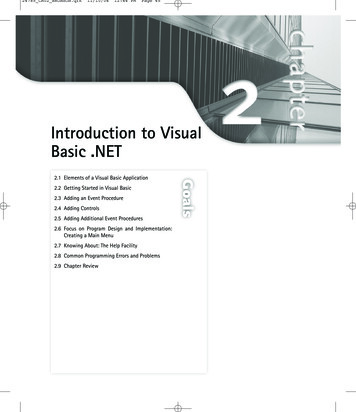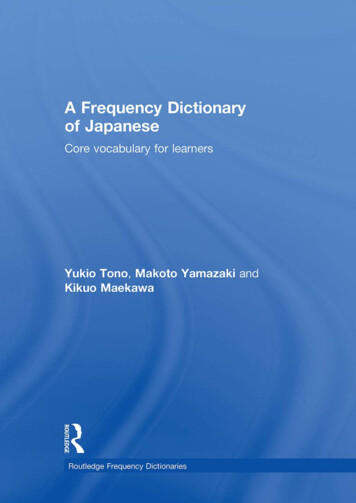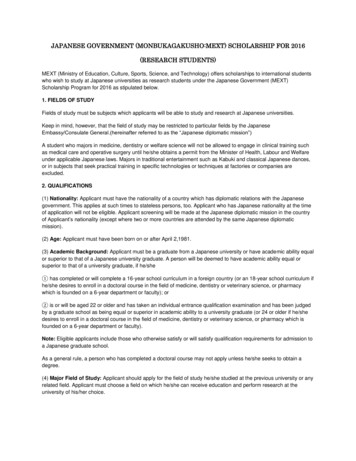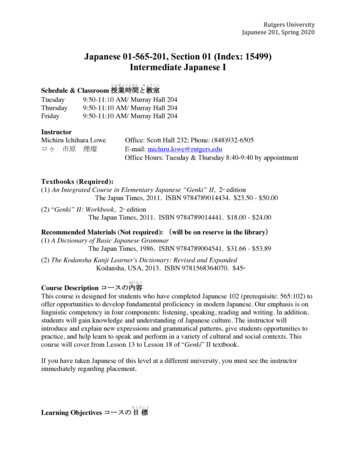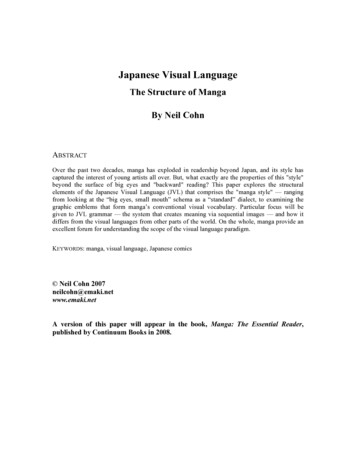
Transcription
Japanese Visual LanguageThe Structure of MangaBy Neil CohnABSTRACTOver the past two decades, manga has exploded in readership beyond Japan, and its style hascaptured the interest of young artists all over. But, what exactly are the properties of this "style"beyond the surface of big eyes and "backward" reading? This paper explores the structuralelements of the Japanese Visual Language (JVL) that comprises the "manga style" — rangingfrom looking at the “big eyes, small mouth” schema as a “standard” dialect, to examining thegraphic emblems that form manga’s conventional visual vocabulary. Particular focus will begiven to JVL grammar — the system that creates meaning via sequential images — and how itdiffers from the visual languages from other parts of the world. On the whole, manga provide anexcellent forum for understanding the scope of the visual language paradigm.KEYWORDS: manga, visual language, Japanese comics Neil Cohn 2007neilcohn@emaki.netwww.emaki.netA version of this paper will appear in the book, Manga: The Essential Reader,published by Continuum Books in 2008.
Japanese Visual Language by Neil CohnMany authors have intuitively associated the “comic” medium to language, andthe same analogy holds with manga. The celebrated “God of Manga” Osamu Tezukacommented on his process by stating, “I don’t consider them pictures in reality I’m notdrawing, I’m writing a story with a unique type of symbol” (Schodt 1983:25). One of thefirst Americans to write about manga, Frederik Schodt, reiterated this, commenting that“manga are merely another ‘language,’ and the panels and pages are but another type of‘words’ adhering to a unique grammar” (1996:26).Schodt’s remarks are perhaps more than just an eloquent metaphor, as recenttheories have proposed that the visual expression of concepts, when put into discretesequences, is literally a form of language (see Cohn 2003, 2005). Like sequential units ofsound in speech or bodily motions in sign languages, sequential drawings ordered by arule system — a grammar — literally comprise a visual language (VL). Culturally, thisvisual language combines with written language in comics, manga, bande desinée, etc.,uniting their readers and authors in a common (visual) linguistic community. Followingthis, unique cultural styles of drawing simply become different visual languages, thesame way that verbal (and signed) languages differ throughout the world.Bearing this in mind, the word “manga” has come to have two meanings outsideJapan. Some use it to designate Japanese “comics,” the socio-cultural objects, and oftenthe industry and community surrounding them. However, others use “manga” to namethis visual language itself — loosely conceived of as an “aesthetic style” (as in Rommens2000). Since the conflation of these ideas can be confusing and inappropriate, in thispiece “manga” will be used in the first sense — to designate a socio-cultural artifact —while referring to the system of graphic expression as “Japanese Visual Language” orJVL. While JVL is the graphic system of communication, “manga” is the socio-culturalcontext in which it appears most.This piece will focus on the structural properties of JVL — what is known abouthow it works and functions — especially in contrast to the visual languages found inother cultures. Many readers are probably familiar with the well-known elements ofmanga. For instance, that manga pages are read right-to-left and that human faces areoften drawn with large eyes and pointy chins. While somewhat superficial in the scope of2
Japanese Visual Language by Neil Cohnthe totality of JVL, at the very least, these features can point towards many deeperinsights into the rich structure of Japanese Visual Language.Standard JVLConceiving of visual creation as a language might seem odd, since the signs areoften iconic — they resemble what they mean — leading to almost universalintelligibility. A drawing of a person means “person” because it looks like a person.Iconic signs differ from two other types of signs: those that are indexical and those thatare symbolic (see Peirce 1931). Indexical signs express meaning by an indicative orcausative relation, such as the index finger when pointing. In contrast, symbolic signsconvey meaning through cultural agreement alone, such as most words. Thesecharacteristics are not rigid categories either — a mixed sign, like a weathervane, mightbe iconic to a rooster, yet indexical to the wind in the direction it points. Symbols are notthe only conventional sign though, 1 since icons and indexes can also appearsystematically throughout a culture. For instance, smiley faces ! are iconic to the humanface, yet they occur in a specific schematic pattern that pervades our culture. In contrast,the faces that are created through life drawing are not conventional at all, since theymimic ever-changing perception of the real world.Traditional thinking about language has held that it only uses symbols (e.g.Hockett 1977; for a dissenting view, see Clark 1997), which would exclude iconicrepresentations, like drawings. The iconicity of images gives the illusion that all drawingsare universal and easy to understand, since they can mimic the character of objects in ourdaily perception. Despite this, the ways “visual speakers” draw people remain justpatterns in the minds of “artists.” This is particularly evident in JVL, since people arecommonly drawn in a recognizable pattern — the stereotypical big eyes, big hair, small1For completeness, Peirce (1931) calls systematically understood signs “Legisigns” and those that areunique and different every time they appear “SinSigns.” Thus, signs that are symbolic are technically“Symbolic Legisigns” while conventional icons are “Iconic Legisigns.” I will refrain from using this jargonthroughout, though his point is important to remember.3
Japanese Visual Language by Neil Cohnmouth, and pointed chins of characters in manga.2 This “style” is so schematized thatoften characters’ faces cannot be distinguished from each other, leading to authors’ use ofother features to allow readers to differentiate them (Rommens 2000; Natsume 1998),such as wildly varying hair color (Levi 1996:12).This predominant manga “style” maintains both conventionality and iconicity,and represents patterns no less cognitive than any other linguistic form. The iconicitymakes it accessible and easily decodable to individuals across the globe, while itsconventionality reflects that its patterns are shared by many “visual speakers.” Someindividuals use this visual vocabulary, while others have drawn from the perceived worldas a template. Others have been inspired by alternative visual styles, like Akira creatorKatsuhiro !tomo, who was influenced greatly by French artists (Schodt 1996:242).Indeed, many manga are drawn in diverse and varying styles, especially in the “artistic”or garo genre. While diversity clearly exists across all genres of manga and warrantinteresting discussion, this piece will focus on the conventionalized manner of drawing.A “language” begins as a cognitive system in an individual’s brain: a collection ofmental patterns organizing the expression of concepts for expression in some sensorialmodality. This system transforms into a “language” culturally, through the mutualintelligibility of various individuals’ cognitive patterns. Speakers of the Tokyo and Kyotovernaculars remain intelligible enough that the broader patterns are labeled as “Japanese,”while the differences are thought of only as unique aspects of “dialects.” Like the waythat Tokyo-ben is considered the “standard” dialect of spoken Japanese, this stereotypical“manga style” can be considered the “standard” dialect of Japanese Visual Language,since it uses a common model for drawing people shared by a broad range of “visualspeakers.” This overarching schema in JVL is commonly attributed to Osamu Tezuka —himself greatly influenced by the drawing styles of Walt Disney and “Western” comics(Gravett 2004). So, just like most other languages in the world, JVL’s graphic vocabularydid not appear out of nowhere, but has been tempered and transmitted from other sources(the same way that spoken Japanese was influenced by Chinese).2Several other patterned types of figures also exist in Standard JVL, depending on what type of person isbeing drawn. For instance, a stereotypical “big strong male” has a conventional style that is consistent yetdifferent from the big-eyed, pointy chin pattern.4
Japanese Visual Language by Neil CohnNo matter what his own inspirations were, Tezuka’s stylistic impact is hard todeny, though most manga today do not mimic the way that Tezuka himself drew. Like alllanguages, JVL changes over time. Since Tezuka’s initial emergence, various graphicdialects have developed under both his influence and that of many others. Truly, at thispoint, people around the globe can easily identify Standard JVL unconnected to anyparticular author’s manner of drawing. The “style” has transcended individuals in thevisual vocabulary of JVL. However, proficient readers can easily tell the differencebetween the more rounded Shojo style or the more angular Shonen styles. Chibi styles areeasily distinguished for their short and cute figures, while various other styles also playoff the abstract schema of Standard JVL in a variety of ways.To the extent that the representations from genres can be grouped intorecognizable “styles,” each constitute a type of “dialect” or “accent” of JVL, since theirpatterns reflect varying degrees of similarity amongst a group of authors. It should alsobe no surprise that these divisions fall into separate genres. Most often, spoken languagesbecome segmented into dialects based on geographical location. However, visuallanguages are predominantly a print culture, so diversity of community isn’t constrainedby location, but established by the type of publication and its audience.To some, the consistency of Japanese drawing styles may appear to stifle creators’innovativeness or individuality. From a VL perspective, creators each find their “visualvoice” within the confines of the system they share. Focus shifts from how their drawingslook to what they say with their drawings. Manga critic and theorist Fusanosuke Natsume(2001) even believes that overemphasis on images detracts from the story. As a language,using a consistent visual vocabulary allows readers the freedom to focus on the content ofthe expressions rather than on the expressions themselves.Furthermore, the systematic and repetitive nature of the drawing style may be oneof the many reasons manga’s popularity has been growing so widespread across theworld. This consistent visual vocabulary provides a systematic and easily accessible stylefor new readers to learn. If a child wanted to “draw like American comics,” the follow upquestion would be “which one?” since American books feature such a diverse range ofgraphic dialects. In contrast, children can easily identify what it means to “draw manga,”because JVL features a standard dialect across a wide range of authors. Copying this style5
Japanese Visual Language by Neil Cohndoes not just mean imitating an individual, but entering into a community of visuallanguage speakers who share a common graphic vocabulary — and through it, a socialidentity as a “visual speaker” of JVL.Indeed, Japanese children imitate Standard JVL in their figures in extremely highproportions (and increasingly outside of Japan), often leading to higher proficiency ingraphic creation than children from other parts of the world (Wilson 2000; Cox et al.2001) (example drawing in Figure 1.). Some work indicates that boys and girls influencesdiffer as well, similar to the differences found in genres ofboys’ shonen versus girls’ shojo manga (Toku 2002). Notonly do Japanese children imitate this style, but they alsoappropriate methods for representing alternative viewpointsto the predominant lateral viewpoints, such as aerial andclose-up views (Toku 2002, 2001).Figure 1. Manga by a Japanese 7 year old (note theEnglish text, used in a common language-learning script)Contrary to the dogmatic claims that imitativedrawing limits children’s creativity (e.g. Lowenfeld 1957;Arnheim 1978), research suggests that most children doactually learn by emulating other sources, and indeed that itleads to increased levels of drawing ability (Wilson andWilson 1977). Truly, copying from manga may actuallyprevent a drop-off in drawing ability that seems to occurduring puberty for children in most cultures except Japan (Toku 2001). Imitative drawingthen not only establishes a community of “visual speakers” using a common visualvocabulary, but it also offers an efficient way of developing proficient graphic skills,consistent with imitative learning in other domains (Tomasello 2000). However, thisshould be unsurprising from a visual language perspective — Japanese children aresimply treating JVL in manga as a language, learning it through exposure, imitation, andpractice.6
Japanese Visual Language by Neil CohnGraphic MeaningsMany graphic signs used in manga extend beyond iconic representations likethose used for people, constituting what Natsume (1997) calls Kei Yu (!"), which areused to represent invisible qualities such as emotions or motion. These can come in twoforms, as highly conventional graphic emblems,3 like sweeping lines to show motion andbubbles encapsulating text to show speech, or as non-conventional visual symbols ormetaphors.Non-conventional visual symbols and metaphors take many forms. Shojo mangaoften make emotional use of non-narrative signs in the backgrounds of their panels, usingpastiches of flowers or sparkling lights to set a mood or hint at underlying symbolicmeaning. Sex especially is often depicted through metaphoric crashing surf orblossoming flowers, or far more suggestively in erotic comics in lieu of the forbiddendepiction of genitalia (Schodt 1983:101). Other creative uses of visual metaphor are moreovert, such as a scene in Osamu Tezuka’s Buddha where arrows pierce through theBuddha’s belly to show the agonizing pain of being poisoned. A similar metaphoremerged in Rumiko Takahashi’s Maisson Ikkoku, where an arrow shoots out of a wordballoon of gossip to stab the heart of a character (Ceglia and Caldesi Valeri 2002). Inmost cases, symbols like these heighten the emotional impact of the representations, orcreatively adapt them to better suit the graphic form.On the other hand, conventional graphic emblems in manga vary in theirtransparency of meaning. In conventional depictions of rage or anger, characters growsharp fangs and pointy claws while fire erupts behind them. This representation’smeaning requires little decoding and seems to have conceptual underpinnings similar toother depictions of anger in comics (Forceville 2005), though using very differentcultural conventions. Other emblems are far more opaque to those who have not learnedtheir symbolic meaning, such as gigantic sweat drops conveying embarrassment or3The term “emblem” for this context comes from gesture research, classifying conventional signs that areconsciously used and understood. Examples include the “peace” sign with the index and middle fingeroutstretched and the others folded, or the middle finger as an expletive (McNeill 1992).7
Japanese Visual Language by Neil Cohnnervousness (Natsume and Takekuma 1995), bloody noses depicting lust (McCloud1993), or the lengthening of the area between the nose and lips to indicate sexualthoughts (Schodt 1983). Even more unusual, some characters will suddenly become“super-deformed” — taking on a hyper-cartoony or “deformed” style — to show aspontaneous general lack of seriousness. A small sampling of these emblems and theirmeanings are depicted in Figure 2. As one would expect from a visual language, many ofthe emblems from manga extend out to other aspects of Japanese visual culture, surfacingnot only in manga, but a variety of other places like animation, street signs, and even inkaomoji — “emoticons” used graphically to represent non-verbal emotions andexpressions in online, cell phone texting, and other written discourse (Katsuno and Yano2002).Figure 2. A small sample of graphic emblems from JVLKinetic lines that show motion are another graphic emblem that has historicallydiffered between American and Japanese visual languages. Comic author and theoristScott McCloud observed that there is the potential for many different types of thesemotion lines (McCloud 1993), and that Japanese authors used a very different strategythan those in America in the mid-to-late twentieth century. Rather than showing lines8
Japanese Visual Language by Neil Cohntrailing the moving object, manga often show the moving object statically with linesstreaming behind it. The result makes the reader feel as though they are moving at thesame speed as the object, and is one of numerous techniques that McCloud claims mangause to give a more subjective viewpoint. Indeed, the use of motion lines as a wholeappears different in manga than in older American comics. Lines commonly substitutefor the object itself to show a blurred motion, or surround an object in a flurry of lines (asin Figure 3). These distinctly different strategies for depicting motion were amongst thefirst characteristics appropriated by English-speaking comic authors as manga increasedin readership in America throughout the 1980s and 90s (McCloud 1996).Figure 3. Various strategies of motions linesThis transmission of emblems from Japanese to American authors illustrates how“language contact” can initiate changes in a system graphically the same way it canverbally. Languages only remain bound by any borders that limit their transmission.Since manga have transcended their geographic borders to a dramatic extant in the pastdecades, it should be unsurprising that JVL has influenced drawers in America andEurope (Rommens 2000; Horn 1996). This influence manifests in a variety of ways. Theappropriation of graphic emblems like kinetic lines appear among the smallest instancesof this influence — akin to how English has borrowed the words tycoon and karaokefrom Japanese with no overarching change to English grammar. Most significantly, inrecent years drawers use the JVL dialects and emblems en masse, and in publication areoften referred to as Original English Language (OEL) manga or Manga Influenced9
Japanese Visual Language by Neil CohnComics (MIC) (Cha and Reid 2005; Arrant 2006). The degree to which the grammar ofOEL manga truly reflects that of native Japanese manga or is merely the JVL vocabularypainted over the grammar of American Visual Language has yet to be studied. However,this influence provides a good example of the conflation of the social construct of“manga” and the visual language they are written in, and represents a prime example ofhow languages can transcend their culture of origins as a cognitive capacity.JVL GrammarAlthough individual images can convey a great deal of information, the real power oflanguage comes from its sequence — combining multiple units to create a cohesivemeaning greater than the parts alone. The system that accomplishes this is the grammarof language, and visual languages draw on their sequence as much as verbal ones do.Most readers should be aware that the pages in Japanese manga are read from right-to-left— the opposite of American comics. While this is an aspect of sequence, it plays anegligible role in the creation of meaning. Rather, the visual grammar is concerned withhow meaning is conveyed to the reader in the content of sequential images, whether thatsequence is organized right-to-left or the opposite.The first major approach to VL grammar was popularized by McCloud, whohypothesized that sequential meaning could be derived from the linear relationshipsbetween panels, accomplished through various types of “panel transitions.” His types oftransitions included (1993:70-72):1. Moment-to-moment – show a short amount of time passing2. Action-to-action – show a whole action occurring3. Subject-to-subject – show a shift from character to character4. Scene-to-scene – shift between two different environments5. Aspect-to-aspect – step outside of time to show aspects of the environment6. Non-sequitur – have no logical relationship between panels10
Japanese Visual Language by Neil CohnWith these categories established, McCloud then analyzed a variety of works to findout what types of transitions they were using and uncovered some interesting results.While American comic books consistently used a high degree of Action, Subject, andScene transitions, Japanese books introduced some Moment transitions and high numbersof Aspect transitions that were otherwise absent in American comics. His proportions aresummarized in Table 1.Table 1. Summary of McCloud’s transitions cross-culturally (McCloud 1993:75-80) 4AmericanJapaneseMoment-to-moment0 5%Action-to-action" 65% 50%Subject-to-subject 20% 25%Scene-to-scene 15% 5%Aspect-to-aspect0 15%Non-sequitur00To account for these differences, McCloud offered two explanations. In contrastto the small pamphlet-style monthly comics in America, he hypothesized that manga’santhology and tank#bon formats allowed for authors to devote more panels to drawingout scenes and focusing on the setting or mood, a sentiment also echoed by Rommens(2000). More radically, McCoud propoposed that Asian culture is less “goal-oriented”than Western culture, and that “Japanese comics often emphasize being there overgetting there” (McCloud 1993:81).In contrast to McCloud’s views, an alternative approach argues that linearrelationships are not sufficient for describing how sequences of images communicate(Cohn 2003). Rather, visual language grammar works in a similar way as any otherlanguage, complete with visual “parts of speech.” Following modern linguistic analysis(for instance, see Chomsky 1965; Jackendoff 2002), instead of looking at the limited4McCloud does not explicitly state percentages. The numbers cited are approximations from his illustratedgraphs.11
Japanese Visual Language by Neil Cohnrange of one panel’s immediate linear juxtapositions, panels can combine to form largerstructures in hierarchic embeddings. Several categories factor into this visual grammar,depicting various “narrative phases” within a broader “Arc” (Cohn 2007; In prep.). Thesephases largely reflect various states in relation to a predicate — the depiction of an eventor situation. An abbreviated list of VL grammatical categories includes:1. Establisher (E) – set up an interaction without acting upon it2. Initial (I) – depict the nascent starting point of an event or action3. Peak (P) – show the maximal point of tension of an event or action4. Release (R) – releases the tension of an event or action5. Refiners (Ref) — act as modifiers by honing in on information contained in one ofthe core categoriesIn addition to these formatives, various processes can expand the repertoire ofexpression by repeating the same category several times. For these purposes, the mostimportant example is when various panels show different characters at the same narrativestate, united by a process of Environmental-Conjunction (E-Conj). An example of thisapproach applied to a manga sequence is provided in Figure 4 (double lines indicate maincategories, modifiers indicated by single lines).Figure 4. Visual language grammar in a Japanese manga (Koike and Kojima1995:223-224).12
Japanese Visual Language by Neil CohnThis example from the manga Kozure Okami [Lone Wolf and Cub] opens with anEstablisher setting up the situation, with the Refiner in the second panel showing moredetail on the first. The third and fourth panels show close up views of different aspects ofthe start of the event in the Initial Phase — the wheel and foot both stepping on makibishinails — united by E-Conjunction (various characters denoted by subscripts). The event ofjumping occurs in the Peak, again with a Refiner to show the spike dropping out of thefoot while in mid-air. It concludes with Releases, as the child looks up at his fatherhanging from a branch, united again by E-Conjunction.From this framework, McCloud’s transitional categories appear only as a“surface” structure in contrast to the deeper hierarchies of visual language grammar. Howthen can we account for the differences McCloud found between Japanese manga andAmerican comics? Do they exist at all, or can they be explained in an alternative way?Panel transitions descrbe the relations between images. By thinking in terms of broaderhierarchic structures, the understanding of sequences becomes far richer, though it shiftsthe focus away from what happens “between” the individual panels, over to how thecontent of panels fits into a larger cognitive architecture.Since “Aspect transitions” largely refer to how panels focus on parts of a scene,these elements could potentially be captured by what is shown in actual manga panels. Inaddition to forming parts of a sequence, panels can serve to “window the attention” of areader onto different parts of a narrative representation (Cohn 2007:64). Panels can becategorized into varying types based on how much information they contain. Macros arepanels that show multiple characters or a whole scene, while Monos show only individualentities. Micros contain less than a whole entity, such as in a close-up of a characterwhere only part of the person is shown at a time. Finally, Polymorphic panels depictwhole actions through the repetition of individual characters at various points in thatevent. These types of panels can be organized from actions to scenes to individualcharacters to less than a character and are graphed in the Lexical Representational Matrix(LRM), shown in Figure 5.13
Japanese Visual Language by Neil CohnFigure 5. The Lexical Representational MatrixUsing the LRM categories as a guide, a study examined the panels in variousAmerican comics and Japanese manga to see what types of panels they were using. Theresults revealed significant differences; percentages are summarized in Table 2. (Cohn2005):Table 2. Percentages of types of panels in American comics versus Japanese manga14
Japanese Visual Language by Neil CohnPolymorphic MacroMonoMicroJapanese (N 12)0.2 (SD 0.3) 47.3 (SD 8.5)42.4 (SD 5.3)10.1 (SD 5.2)American0.4 (SD 0.7) 59.3 (SD 33 (SD 8.3)6.7 (SD 6.5)(N 12)14.1)With higher usage of Micros and Monos, JVL seems focus on individual parts ofenvironments more often than on larger scenes that show the environment outright(Macros), which is essentially what McCloud’s approach said as well! These findings tellus that JVL tends to focus attention on individual characters almost as often as it doeswhole scenes.Not only do these findings tell us about the patterns of single panels, they can alsoindicate possible trends in visual grammatical structures. High quantities of Monos meanthat their grammar likely uses a fair amount of Environmental-Conjunction. If thisimplication is true, then Japanese manga focus on varying parts of a scene morefrequently than American comics do, carrying the necessary grammatical structures.Similarly, the larger number of Micros insinuates a greater use of Refiners as well. Ascan be seen quite well in the example in Figure 4, Refiners and E-Conjunction both showvarious parts of an event at a single narrative state without placing all the informationinto the contents of a single panel.This expansion of information across several panels echoes McCloud andRommen’s observations that manga draw out the representations of events instead ofsimply showing the actions in the setting outright. It should be important to note thatneither strategy is inherently “better” or “worse” than the other. More compactrepresentations likely require less cognitive processing than those with extensive use ofmodifiers. On the other hand, increased panels place meaning more firmly in the graphicdomain than the verbal.Indeed, Japanese manga seem to use less text than American comics, placingmore of the communicative focus on the visuals (Rommens 2000). While the appeal of agreater length in publishing format might be one explanation for this expansion of scenes,it rings a bit hollow without empirical verification. Just because manga authors havemore pages at their disposal does not insinuate that they use it to “decompress” their15
Japanese Visual Language by Neil Cohnscenes. They could just as easily fill that space with compact event representation andeven more plot. An alternative viewpoint might say that they use the visual system as alanguage — allowing the visuals to express meaning through their own capacities andthus requiring more length to do so. In fact, Gravett (2004:26) recounts that in theopening sequence of Osamu Tezuka’s first hit, Shin-Takarajima [New Treasure Island],his intended 31 panel sequence was shortened to only four panels, despite launching anew, longer format of manga. However, both the published and unpublished versions relyalmost solely on visual information. Placing the focus on the visuals at the expense of theverbal is consistent with other research in multimodality, which suggest that the less theverbal form dominates meaning, the more complex the nature of other modalitiesbecomes (e.g. Wilkins 1997; Goldin-Meadow 2006).Like any language, studies indicate that sequences of images also require degreesof fluency (Nakazawa 2005). In psychology experiments, subjects were asked toreconstruct four panels of a scrambled manga strip or to fill in the blank of the contents amissing panel. Results showed that performance improved with age from kindergartenthrough adulthood, attributed to experience with manga reading (Nakazawa andNakazawa 1993; Nakazawa 2004). Another study compared the eye-movements ofmanga reading between a child who reads manga frequently versus one who hard
Indeed, many manga are drawn in diverse and varying styles, especially in the ÒartisticÓ or garo genre. While diversity clearly exists across all genres of manga and warrant interesting discussion, this piece will focus on the conventionalized manner of drawing. A ÒlanguageÓ beg
